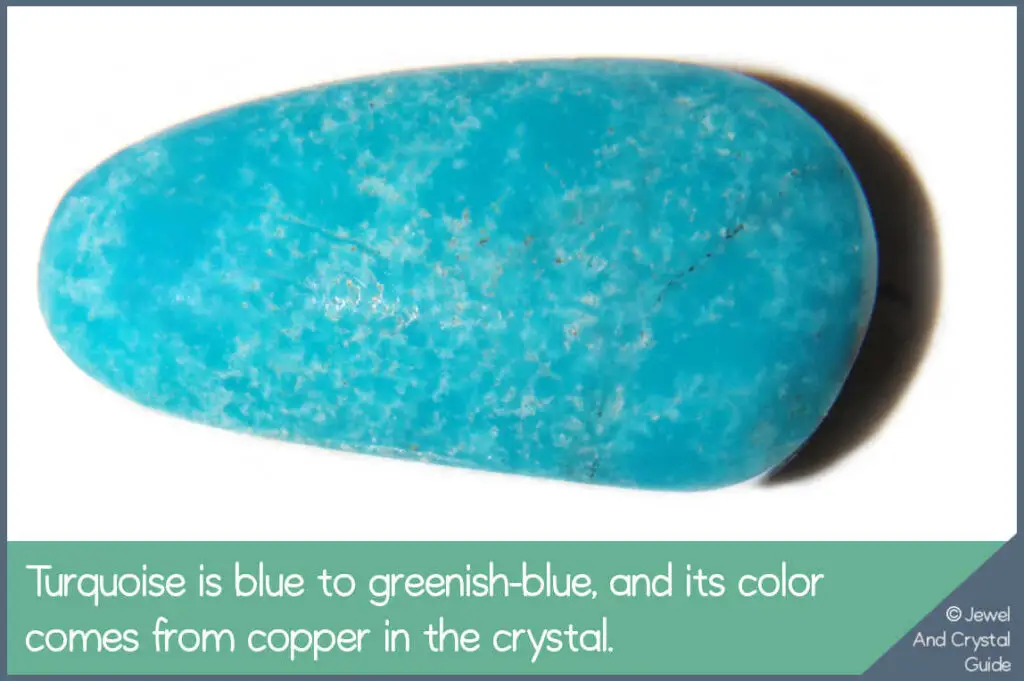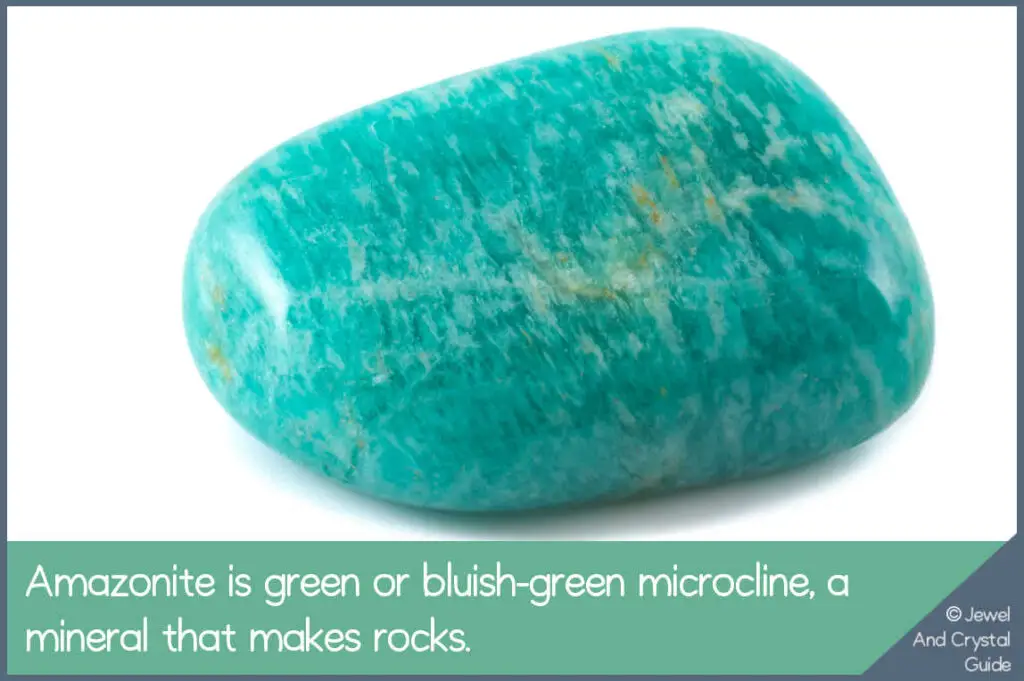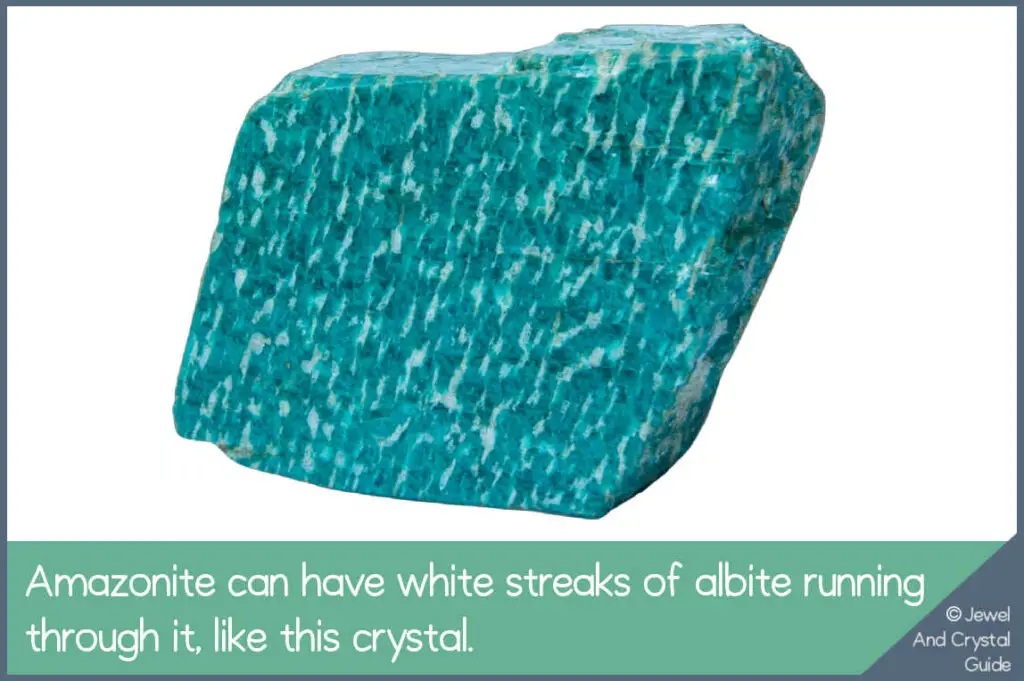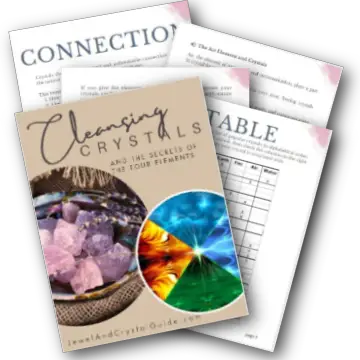Turquoise and amazonite are both beautiful green/blue crystals, but they have some distinct differences when you know what to look for…
Turquoise is blue to greenish-blue from copper. It’s opaque, letting no light through, often with brown or black patches or veins on it. Amazonite is green or blue-green from lead. It’s opaque to semi-translucent, letting none or some light through, and often has white streaks of albite.
Let’s explore what makes turquoise different from amazonite, and how you can test a piece to tell which crystal it is.
In this blog post, you’ll discover:
- The differences between turquoise and amazonite
- A table summarizing all these differences
- How to test for turquoise and amazonite
The differences between turquoise and amazonite
Here’s a list of differences between turquoise and amazonite…

Turquoise is hydrous phosphate, amazonite is feldspar
Turquoise is a hydrous phosphate crystal, made up of copper and aluminum. Amazonite is a type of feldspar crystal called microcline, and it’s mainly made up of potassium, aluminum, silicon, and oxygen.
Turquoise:
Turquoise is a crystal. If something’s called a crystal, it’s usually a mineral found in nature, with well-formed, recognizable crystal shapes. Turquoise is a mineral with a distinct crystalline structure, even if it isn’t as well-defined or transparent as some other crystals.
Turquoise crystals form deep underground, when water with copper and aluminum in it comes into contact with certain rocks in the ground.
Over thousands or millions of years, the minerals in the water cool down and harden. Turquoise crystal slowly takes shape and becomes a solid crystal through this process.
Turquoise is so pretty and valuable that we often use it to make jewelry, like necklaces, rings, and bracelets, but it’s also used for decorations and carvings.
Amazonite:
Feldspar is a family of minerals that are abundant in the Earth’s crust, found in different types of rocks.
Feldspar is made up of aluminum, silicon, and oxygen, along with other elements like potassium, sodium, calcium, or barium.
Amazonite is the green variety of microcline feldspar, which is a hard potassium feldspar.
Different minerals make turquoise and amazonite green
Copper makes turquoise green, while lead and water turn amazonite green.
Turquoise:
Turquoise has a blue to greenish-blue color, sometimes described as “robin’s egg blue.” Turquoise’s coloring is usually more vibrant and vivid than amazonite’s softer and more pastel green tones.

When the copper in turquoise crystal combines with other elements, like aluminum, it gives turquoise its beautiful colors. The shade of blue or blue-green depends on how much copper is in the crystal.
Amazonite:
Amazonite is typically light to medium green or blue-green, with shades ranging from a pale, minty green to a deeper bluish-green, or even a turquoise-like hue.

Most of amazonite’s coloring comes from the combination of lead and water, along with other trace elements:
- The more lead there is, the greener the crystal becomes.
- Water molecules in an amazonite’s structure influence the way light interacts with the crystal. Water molecules affect the absorption and reflection of light, making variations in the colors we see when we look at the crystal.
- Other factors can have a small influence on the crystal’s color, for example the presence of iron or copper.

Get a full overview of amazonite crystals and links to my other relevant articles in this guide.
Turquoise and amazonite have different markings on them
A lot of turquoise has matrix patterns on it, which usually look like dark veins or patches of brown or black.

A matrix forms when other minerals, like iron oxides or manganese, are in the surrounding rock and get trapped in turquoise as it forms.
Amazonite often has white streaks, patches, or banding in it. The white portions are usually from a mineral called albite, which is another type of feldspar.

Amazonite tends to be more even than turquoise
Raw amazonite usually has a more even and more polished surface than raw turquoise, which you’ll notice if you run your fingers over these crystals. Once amazonite and turquoise are cut and polished, both crystals become smooth and shiny.
Raw amazonite from the ground feels a little grainy but with a flush surface that’s pretty much even, and the surface often has a slightly waxy or pearly shine.

Raw turquoise, on the other hand, tends to have an uneven surface with many lumps and bumps on it. These lumps and cavities are from the matrix of other minerals often found in turquoise (seen as black or brown markings) and the way turquoise forms in nature.

Turquoise and amazonite form in different shapes
Both amazonite and turquoise belong to the triclinic crystal system. But amazonite usually forms hexagonal prisms, while turquoise is commonly found in massive, nodular, or vein-like shapes.
Amazonite usually forms in clusters of prism blocks that are irregular in shape. These prisms have long, slender faces (sides) with a hexagonal cross-section that has 6 sides.
Turquoise typically grows in massive, nodular, or vein-like forms. It rarely has well-defined crystals with distinct faces because of the conditions under which it is created.
Instead, turquoise is often found in compact, irregular masses or nodules, and it can fill fractures or veins in host rock.
Turquoise and amazonite have different levels of transparency
If a crystal is translucent, it lets light pass through it. You get different levels of translucency, with some crystals being very translucent and others being only slightly translucent.
Transparency, on the other hand, refers to how well you can see what’s on the other side of the crystal.
And here’s the trick: a crystal must be translucent to let light through it to be transparent. If a crystal doesn’t let any light through at all, it’s opaque and not transparent.
A crystal must be translucent to be transparent. Translucent means it lets light through. Transparent means you can see what’s on the other side.
Amazonite is more transparent or see-through than turquoise because it is can be semi-translucent, which means it lets some light through it. Turquoise is opaque and doesn’t let any light pass through, so it’s not transparent.
When you shine a light through amazonite, it might let some light through and you get a glowing effect or a soft glow. But most amazonite is opaque, so this isn’t a definitive test for amazonite.

When you shine a light through turquoise, you don’t see any light come through the crystal on the other side. This is proof that turquoise is not translucent or transparent.
Amazonite and turquoise come from different places
Amazonite and turquoise come from different places around the world, based on where the right geological conditions and minerals were present to create these types of crystals over many, many years.
Below are the top three places where amazonite is found:
- United States: Amazonite is famously found in Colorado, particularly in the Pikes Peak region. Crystals from this location often have a beautiful blue-green color with white veins in them from the mineral albite.
- Russia: Amazonite is also found in Russia, particularly in the Ural Mountains. Russian amazonite has an intense green color and is very valuable in the gemstone market.
- Madagascar: Madagascar is another important source of amazonite. Crystals from Madagascar can have various shades of green in them, and some are quite translucent.
Below are the top three places where turquoise is found:
- United States: Arizona is famous for producing some of the world’s finest turquoise. The state is home to several well-known turquoise mines, including the Sleeping Beauty Mine and the Kingman Mine.
- Iran: Iran has been a significant source of turquoise for centuries. Persian turquoise is highly regarded for its beautiful blue color and often contains detailed matrix patterns.
- China: China is another major producer of turquoise. Chinese turquoise varies in color and matrix patterns, and it’s widely used in jewelry and ornamental carvings.
Turquoise and amazonite are good for different things
Amazonite and turquoise have distinct and unique metaphysical properties. While both share some common traits, they each bring you different gifts.
Turquoise is good for:
- Protection: Turquoise is a protective crystal, historically worn as amulets to create a shield around the wearer and safeguard against negative energy, accidents, and harm.
- Positive Energy: Turquoise attracts positive energy and good fortune. It brings luck and blessings to those who wear it and keep it close by.
- Healing and Health: Turquoise has healing properties, particularly for the immune and respiratory systems. The crystal also helps with detoxification and overall well-being.
- Spiritual Awareness: Turquoise is a stone of spiritual awareness and connection. It enhances intuition, opens the third eye chakra, and brings spiritual growth and insight.
- Self-expression: Turquoise encourages self-expression and improves the way you communicate your thoughts and feelings, so you speak with clarity and confidence.
Amazonite is good for:
- Communication: Amazonite improves communication skills, both in being able to express yourself and listening to others. The crystal helps you with open and honest dialogue, making it a great help with relationships and resolving conflicts.
- Calming and Soothing: Amazonite is a calming and soothing crystal. It reduces stress, anxiety, and nervousness, bringing peace to the mind and emotions.
- Harmony and Balance: Amazonite brings a sense of harmony and balance in life. The crystal aligns thoughts and actions with inner truths, so you enjoy a greater sense of self-awareness and self-acceptance.
- Creativity: Amazonite stimulates creativity and imagination. It helps with breaking through creative blocks and inspires fresh ideas in artistic pursuits.
- Physical Health: Amazonite is believed to support the throat, thyroid, and nervous system. The crystal also helps maintain overall well-being.
Turquoise is more valuable than amazonite
Turquoise tends to be more valuable than amazonite because of its historical significance, cultural importance, and the rarity of high-quality specimens, especially those with intense blue colors, minimal matrix, and from renowned sources like Persian turquoise.
Also, the enduring demand for turquoise in the jewelry market contributes to its higher value compared to the more abundant and widely available amazonite.
But it’s good to remember that the value of crystals depends on things like color, clarity, size, and origin. Prices can also fluctuate over time due to supply and demand.
Table of differences between turquoise and amazonite
The table below is a quick guide to all the differences between turquoise and amazonite that I explained in detail above:
| Property | Turquoise | Amazonite |
| Crystal Type | Hydrous phosphate | Feldspar |
| Color | Blue to greenish-blue (from copper) | Green or bluish-green (from lead and water) |
| Raw Texture | Lumpy and bumpy | Smooth and waxy |
| Transparency | Opaque | Semi-translucent and semi-transparent |
| Raw Forms | Massive, nodular, vein-like | Prismatic, tabular, clusters, massive |
| Matrix Patterns (Markings And Colors) | Dark brown or black veins or patches | White veins |
| Good For | Protection, positive energy, healing, spiritual awareness, self-expression | Communication, calming, harmony, creativity, physical health |
| Main Sources | USA (Arizona), Iran, China | USA (Colorado), Russia, Madagascar |
| Value | More valuable | Less valuable |
How to tell if a crystal is turquoise or amazonite
While professional testing is the most accurate way to determine whether a piece is turquoise or amazonite, here are a few simple tests you can do to gather some initial information:
Color Observation
Take a close look at the crystal, preferably in natural sunlight.
If it’s amazonite, it’s most likely to have shades of light to medium green or blue-green, often with white veins or streaks.
A turquoise crystal has a blue to greenish-blue color that makes you think of the sky. It may also have dark marks like veins or patches on it.
Transparency Check
Now hold the crystal up to a strong light, such as a lamp or flashlight.
Amazonite is usually semi-translucent, allowing some light to pass through so it creates a glowing effect. You might even be able to see blurred images of objects on the other side of the crystal.
Turquoise is opaque, except when it’s cut very thin. Opaque means it does not let light through, so it’s solid without any transparency under light. You can’t see anything through a turquoise crystal.
Acid Reaction Test
The crystal must be unpolished for an acid reaction test to work.
If possible, scratch the crystal a little with a steel knife and leave the dust on the crystal for this test.
Now put a drop of vinegar on the crystal, where the dust is if you made some.
Amazonite is not usually affected by acid and shouldn’t show any reaction to the vinegar.
Turquoise can be sensitive to acids. If the crystal is turquoise (or another crystal that’s also sensitive to vinegar), you might see some small bubbles when the copper in the crystal reacts to the acid in the vinegar.
Want to remember this? Save this post on The Differences Between Amazonite and Turquoise to your favorite Pinterest Board below!












